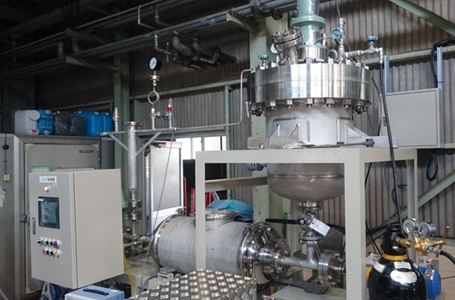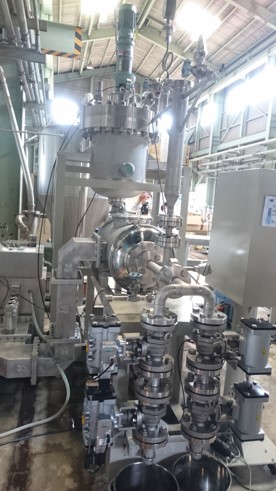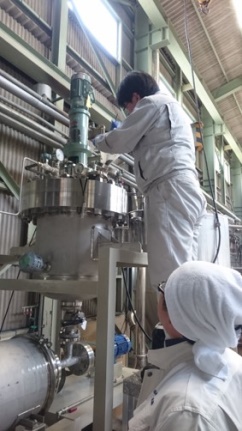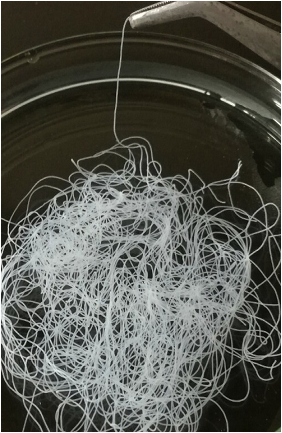2016 Activity Report for Mission 5-2: Establishing a Society with Reduced Dependence on Fossil Resources: Plants, Biomass, Energy, and Materials
Updated: 2018/05/18
<Molecular Breeding of Biomass Plants and Synthetic Biology>
Research1: Tailor-made breeding of grass biomass through lignin bioengineering (Toshiaki Umezawa, Yuki Tobimatsu, Shiro Suzuki)
To explore new breeding strategies to improve the production of bioenergy and biomaterials from grass biomass, this project seeks to develop and characterize transgenic rice plants that produce biomass with variously modified lignin contents and structures. We are also working on the selection and breeding of grass biomass crop varieties with superior lignin characteristics.
Research Activities
- Transcription factor-mediated upregulation of rice lignin biosynthesis for the production of energy-rich biomass.
- Development of transgenic rice plants with variously altered lignin aromatic composition.
- Metabolic engineering of grass-specific lignin modification substructures.
- Biomass properties and variety selection of grass biomass crops, e.g., sorghum, erianthus, and sugarcane
Publications, etc.
Koshiba T. et al., MYB-mediated upregulation of lignin biosynthesis in Oryza sativa towards biomass refinery. Plant Biotechnol., in press. DOI: 10.5511/plantbiotechnology.16.1201a.
Research2: Development of isoprene production utilizing solar energy with photosynthetic microorganisms (Kazufumi Yazaki, Akifumi Sugiyama)
Isoprene is used worldwide as an industrial compound in materials such as synthetic rubber. Currently, the isoprene supply depends fully on fossil fuels, which will be depleted in the future. Thus, the development of a sustainable isoprene production method is required. In this study, we aim to establish methods to produce isoprene from sustainable resources, such as diatom (Chaetoceros gracilis), a photosynthetic microorganism, by metabolic engineering using an isoprene synthase gene from Populus alba.
Research Activities
- A transgenic diatom (Chaetoceros gracilis) expressing IspS of Populus alba was generated.
- Isoprene production was achieved in the transgenic diatom.
Publications, etc.
We filed patent applications.
<Innovative Biomass Conversion Technologies>
Research3: Conversion of biomass into chemical resources using a microwave and biological process (Takashi Watanabe, Hiroshi Nishimura)
Research Activities
- Lignin monomers for epoxy resin were produced with high selectivity by industry−university joint research. We succeeded in controlling the thermodynamic properties of the lignin-based epoxy resin by designing a chemical modification of the monomer unit. We analyzed detailed structures of the lignin oligomers produced, and reported these results in original papers.
- Lignin monomers for functional polymers were produced in a yield more than twice that of conventional heating. A continuous 915 MHz microwave reactor was developed by industry−university joint research and applied to the degradation of woody biomass. The mechanisms underlying the acceleration effects were analyzed using model compounds.
 |
|
 |
 |
| Figure: Continuous 915 MHz microwave reactor developed by CREST project and experiments of wood degradation. | |
Publications, etc.
- A. Kaiho, D. Mazzarella, M. Satake, M. Kogo, M. R. Sakai, Takashi Watanabe, Construction of di(trimethylolpropane) cross linkage and phenylnaphthalene structure coupled with selective β-O-4 bond cleavage for synthesizing lignin-based epoxy resins with controlled glass transition temperature. Green Chem., 18, 6526-6535 (2016).
- K. Saito, A. Kaiho, R. Sakai, H. Nishimura, H. Okada, Takashi Watanabe, Characterization of the interunit bonds of lignin oligomers released by acid-catalyzed selective solvolysis of Cryptomeria japonica and Eucalyptus globulus woods via thioacidolysis and 2D-NMR, J. Agric. Food Chem., 64, 9152–9160 (2016).
Research4: Design of green biomass conversion based on an analysis of branched structures on lignocellulose (Hiroshi Nishimura, Takashi Watanabe)
To design a separation and a conversion of lignocellulose, knowledge of molecular structures in a branched lignin and lignin−carbohydrate complex is important. Here, we explore new enzymatic conversion processes based on the fundamental analysis for lignocellulose molecules.
Research Activities
- Development of a 2D-NMR method for the accurate quantification of lignocellulose.
- Fractionation of lignin-carbohydrate complex from wood biomass.
- Enzymatic reactions for the cleavage of lignin-carbohydrate linkages.
Publications, etc.
- Okamura, H., Nishimura, H., Nagata, T., Kigawa, T., Watanabe, T., Katahira, M., Accurate and molecular-size-tolerant NMR quantitation of diverse components in solution. Sci. Rep. 6, 21742 (2016).
- News (in Japanese), The Chemical Daily (2016).
<Advanced Functional Materials from Biomass>
Research5: Development of high-strength products based on cellulose and chitin nanofibers (Hiroyuki Yano, Kentaro Abe)
Recently, natural nanofibers such as those of cellulose and chitin, which are major components of plant cells and the shells of crabs and shrimp, respectively, have received great interest by virtue of their outstanding mechanical properties. The aim of this study is to develop high-strength products (film, spun fiber, filters, etc.) based on cellulose and chitin nanofibers.
Research Activities
- Simple nanofibrillation of high-concentration pulps
- Wet-spinning of cellulose nanofiber

(Figure) Wet-spun fiber based on cellulose nanofiber.
Research6: Development of energy storage device from biomass (Toshimitsu Hata, Yoshikazu Onishi)
Electrode materials for electric double-layer capacitors with high purity and high carbonization yield are the primary factors in the energy density and charge and discharge performance. In this research, composite carbon materials from woody biomass and thermosetting phenolic resin are prepared to develop a high-performance electrode material.
Research Activities
- Evaluation of pore sizes of specimens with different carbonization temperatures by CO2 adsorption measurement.
- SEM observation of dispersion of cellulose nanofibers in thermosetting phenolic resin.
- Analysis of micropore distribution in composite carbon material.
<Implementation of Microwave-based Wireless Power Transmission Technologies>
Research7: Development of IoT technology with wireless power transfer via microwaves (Naoki Shinohara, Tomohiko Mitani)
Toward a post-fossil-fuel society, IoT (Internet Of Things) technology for a sophisticated society is required. In this project, we are developing an unconscious wireless charging system and battery-less sensor with wireless power transfer via microwaves. We propose new IoT technology with wireless communication and wireless power and carry out field experiments.
Research Activities
- Development of battery-less sensor with wireless power transfer via microwaves for nursing homes as a JST research project named ‘Center of Innovation’ at Kyoto University.
- ・Development of a battery-less sensor with wireless power from a flying multi-copter to measure the parameters of volcanos, and field experiments of the developed systemon Izu island and in Fukushima prefecture.
Publications, etc.
- Christos Kalialakis, Nuno Borges Carvalho, Naoki Shinohara, and Apostolos Georgiadis, Selected developments in wireless power transfer standards and regulations, IEEE Standards University E-Magazine, , 2016.3.
- http://www.standardsuniversity.org/e-magazine/june-2016/selected-developments-wireless-power-transfer-standards-regulations/
- (Invited) Naoki Shinohara, Antennas for Wireless Power Transmission, 10th European Conference on Antenna and Propagation (EuCAP2016), Davos, 2016.4.10-15, CD-ROM 1570245673.pdf.
- (Keynote) Naoki Shinohara, Current Research and Development Activities of Wireless Power Transfer via Radio Waves, IEEE Wireless Power Transfer Conference(WPTc2016), Aveiro, 2016.5.5-6.
- Naoki Shinohara, Simultaneous WPT and Wireless Communication with TDD Algorithm at Same Frequency Band (Chapter 9), Wireless Power Transfer Algorithms, Technologies and Applications in Ad Hoc Communication Networks, eds. Sotiris Nikoletseas, Yuanyuan Yang, and Apostolos Georgiadis, Springer, ISBN 978-3-319-46810-5, 2016.7, pp.211-230.
Research8: Estimation of microwave impacts on insect ecology from human activity (Aya Yanagawa, Tomohiko Mitani)
The demand for microwave technology will continue to increase. For the safety and development of the IoT (Internet of Things), it is essential to learn its impacts on nature. We would like to establish a method for estimating such impact by using insect ecology as a model system.
Research Activities
- ESR analysis of sample insects.
- Measuring the electric permittivity of architectural/building materials.
- Check the microwave power-dependent microbial susceptibility change on termites.


